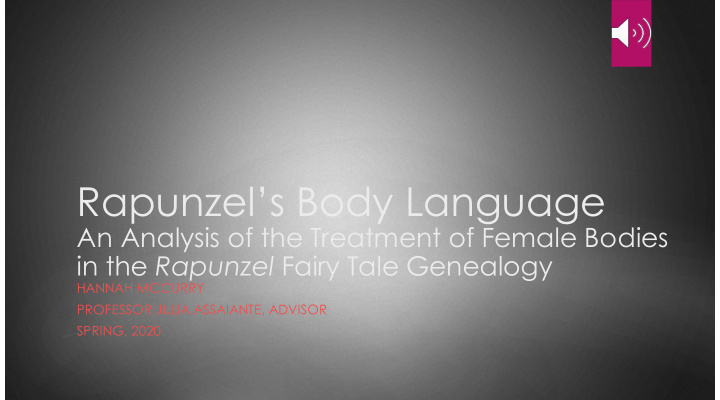



Rapunzel’s Body Language An Analysis of the Treatment of Female Bodies in the Rapunzel Fairy Tale Genealogy HANNAH MCCURRY PROFESSOR JULIA ASSAIANTE, ADVISOR SPRING, 2020
Petrosinella by Giambattista Basile 1634; Italian � The Roots Persinette by Mlle. de La Force 1698; French � Rapunzel by Friedrich Schulz 1790; German �
Petrosinella (Basile) Petrosinella’s body is acted upon in ways she agrees to � She uses her wits to escape the Ogress � The chase scene at the end allows for agency �
Persinette (de La Force) Persinette is “beautiful as the sun,” obedient, and quite naïve � Sudden marriage before subsequent pregnancy � Both of which Persinette is shown to be ignorant � Her hair is used throughout, and cut off by the Fairy at the end as punishment � She saves the Prince with her tears and the Fairy is redeemed at the end �
Rapunzel (Schulz) Direct translation of the French Persinette into German with two subtle � additions to the tale: A hook is added for Rapunzels benefit, to help her pull the Fairy and the � Prince up the tower Rapunzel comments that “all her dresses were becoming too tight” � Ignorance of her body � Physical and mental weakness associated with Rapunzel �
The Grimms‘ First Version of the Rapunzel tale by the Grimms Seeds for the 1812 � Future Second Version 1857 of the Rapunzel tale by the Grimms 1857 �
First Version in 1812 No sudden marriage in this tale, but Rapunzel still becomes pregnant � The Fairy cuts off Rapunzels hair as punishment � No redemption of the Fairy at the end of the tale �
Second Version in 1857 Reinstate the sudden marriage before Rapunzel becomes pregnant � The Sorceress cuts off Rapunzel’s hair as punishment � This is the most influential version of the tale � What’s kept? What’s edited out? �
Rapunzel by Anne Sexton 1972 � The Modern Disney’s Tangled directed by Nathan Greno Branches and Byron Howard 2010 � Rapunzel, Rapunzel by Nikita Gill 2018 �
Rapunzel (Sexton) Rapunzel‘s body is objectified and sexualized, not by the Prince, but by � Frau Gothel Possession of Rapunzel‘s body is is central to this poem �
Tangled (Disney) Tangled is loosely based on the Grimms‘ version, with many differences � What stays: � Rapunzel‘s naivety � Rapunzel‘s hair is cut off by hands that are not her own � Rapunzel‘s tears heal the Prince-figure � Reinstate the chase scene � Does this give Rapunzel agency again? �
Rapunzel, Rapunzel (Gill) “Rapunzel, Rapunzel, ask yourself why you let down your hair. Ask yourself, would anyone who truly loves you ever allow it to be subject to such wear and tear?” (Gill, 84) Rapunzel realizes that her body should not be used by anyone � She cuts off her own hair and uses it to escape and free herself � All she needed was „hiding in the marrow inside [her] own powerful spine, � [her] own bones“ (Gill, 84)
Conclusion Petrosinella (Basile) Persinette (de La Force) Rapunzel (Schulz) Rapunzel (Grimms) Rapunzel (Sexton) Tangled (Disney) Rapunzel, Rapunzel (Gill)
Works Cited Basile, Giambattista. Petrosinella . Edited by Helen Zimmern. Translated by � John Edward Taylor. Fisher Unwin. 1912. de La Force, Charlotte-Rose de Caumont. Persinette . Translated by Laura � Christensen. 2014. Gill, Nikita. Fierce Fairytales: Poems & Stories to Stir Your Soul. Hachette � Books. 2018. Greno, Nathan and Howard, Byron, directors. Tangled . Walt Disney � Animation Studios, 2010. Grimm, Jacob and Wilhelm. Kinder- und Hausmärchen . 1st ed. Berlin. v. 1, � no. 12. 1812. Grimm, Jacob und Wilhelm. Kinder-und Hausmärchen . 7th ed. Nikol. 2014. � Schulz, Friedrich. Rapunzel . Translated by Oliver Loo. 2015. � Sexton, Anne and Susa, Conrad. Transformations: an Entertainment in Two � Acts from the Book of Anne Sexton . Open Road Media, 2016.
Recommend
More recommend